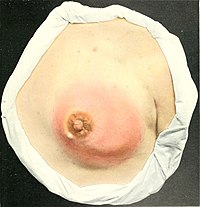
Photo from wikipedia
Clinical mastitis affects 3% of primiparous dairy cattle (heifers) in the first month after calving. Additionally, the prevalence of intramammary infection (IMI) in the months before first calving is high,… Click to show full abstract
Clinical mastitis affects 3% of primiparous dairy cattle (heifers) in the first month after calving. Additionally, the prevalence of intramammary infection (IMI) in the months before first calving is high, resulting in a high prevalence of heifers calving with IMI. Precalving therapy is an accepted recommendation for reducing mastitis in multiparous cows, but prophylactic treatment for heifers is uncommon in North America. Objectives of this study were to (1) quantify changes in postcalving udder health in heifers following application of a precalving treatment; (2) compare effectiveness among various types of treatments; and (3) compare effectiveness of various types of treatments against specific pathogens. A systematic review was conducted comparing interventions aimed at improving udder health in heifers. Of 62 included studies, 48 clinical trials were used in a meta-analysis. Data were synthesized using a random effects model for meta-analysis, followed by sub-group analyses comparing treatment types, and specific pathogens with statistical testing using meta-regression. Occurrence of mastitis (defined as elevated somatic cell count, clinical mastitis, and IMI) was reduced in treated heifers compared with untreated controls with a pooled risk ratio of treated to untreated heifers of 0.56 (95% confidence interval: 0.47 to 0.67). Upon stratification by treatment types, teat sealants and combination therapies (vaccines and antimicrobials; antimicrobials and teat sealants; and all 3) were most effective at improving udder health with pooled risk ratios of 0.40 (95% confidence interval: 0.30 to 0.52) and 0.34 (95% confidence interval: 0.25 to 0.45), respectively. Antimicrobials and vaccines also reduced occurrence of IMI and subclinical and clinical mastitis when compared with untreated heifers. Although variation was observed in the pathogen-specific effectiveness of treatments at reducing rates of disease, antimicrobials, teat sealants, and combinations of vaccines or teat sealants with antimicrobials were consistently effective, whereas vaccines were only effective for contagious pathogens. Recommendations for use of antibiotics should consider their relative benefit while also considering potential for increasing antimicrobial resistance.
Journal Title: Journal of dairy science
Year Published: 2018
Link to full text (if available)
Share on Social Media: Sign Up to like & get
recommendations!